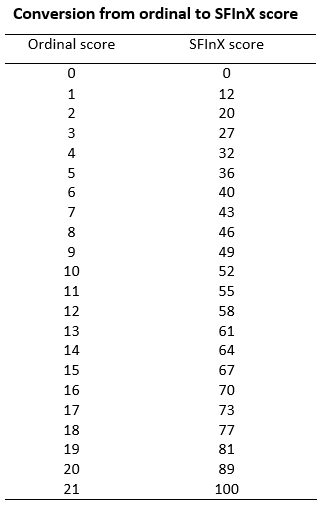During the development of the SFInX in people recovering from a proximal humeral fracture, measurement properties of the SFInX (such as convergent validity and intra-rater reliability) have been thoroughly tested and evaluated. With Rasch analysis we evaluated the structure of the SFInX, its (uni)dimensionality, item difficulties and estimations of individuals’ shoulder function. Also through Rasch analysis, an interval-level (ruler-like) scale from 0 to 100 was created.
Here we present an overview of measurement information.
- Hierarchy of SFInX items (by difficulty of activity)
- Measurement properties
- Rasch converted SFInX scores
Based on the difficulties of the 13 SFInX items, the hierarchy of items would be as below.
Hierarchy of items
|
Hardest
Easiest |
ITEM 3 washing back opposite shoulder |
| ITEM 6 washing lower back | |
| ITEM 12 moving an object above head level | |
| ITEM 13 throwing a ball with two hands overhead | |
| ITEM 4 combing hair/running hand through hair | |
| ITEM 8 reaching behind to get an object | |
| ITEM 10 carrying a heavy object with two hands | |
| ITEM 11 placing an object on a shelf at shoulder level | |
| ITEM 5 tucking shirt into pants | |
| ITEM 9 holding an object for a longer period | |
| ITEM 2 washing opposite armpit | |
| ITEM 7 lying on affected side | |
| ITEM 1 drinking from a cup |
An overview of the measurement properties of the SFInX for people recovering from a proximal humeral fracture can be found below in the Table “SFInX measurement properties”
| SFInX measurement properties | |
| Validity | |
| Content validity | SFInX items have been linked to the WHO International Classification of Functioning, Disability and Health (see SFInX User Manual) |
| Face validity | SFInX items have been generated and endorsed by orthopaedic surgeons, physiotherapists and occupational therapists |
| Construct validity | |
| Structural validity | 66.3% of total variance was explained by the 13 items Rasch analysis confirmed unidimensionality |
| Convergent validity | Pearson’s r = 0.73 to 0.89 with other shoulder measures |
| Discriminant validity | Pearson’s r = -0.08 with different construct (cognition) |
| Known-groups validity | 33.7 points difference (95%CI 21.0 to 46.3; t=-5.37, p<0.01) between people less than 3 months post-fracture compared to people more than 9 months post-fracture |
| Longitudinal validity (responsiveness) | Pearson’s r (change scores) = 0.40-0.49 with other shoulder measures, indicating the SFInX being more responsive to change |
| Reliability | |
| Internal consistency | Person separation index was 2.90, person reliability of 0.89Item separation index was 6.10, item reliability of 0.97 |
| Test-retest reliability | ICC2,1(agreement) = 0.96 (95%CI 0.94 to 0.97) |
| Measurement error | SEM = 3.9 / 100 points |
| Minimal Detectable Change | MDC95 = 10.8 |
| Inter-rater reliability | ICC2,1(agreement) = 0.91 (95%CI 0.63 to 0.97) |
| Measurement error | SEM = 5.8 / 100 points |
| Clinically important difference | |
| Minimal | 10-12 / 100 points |
| Moderate | 17 / 100 points |
Rasch converted SFInX scores
Using Rasch analysis, raw (ordinal) scores were converted into SFInX scores which created an interval-level (ruler-like) scale of shoulder function.
Minimum score: 0 points = 0 SFInX score
Maximum score: 21 points = 100 SFInX score

